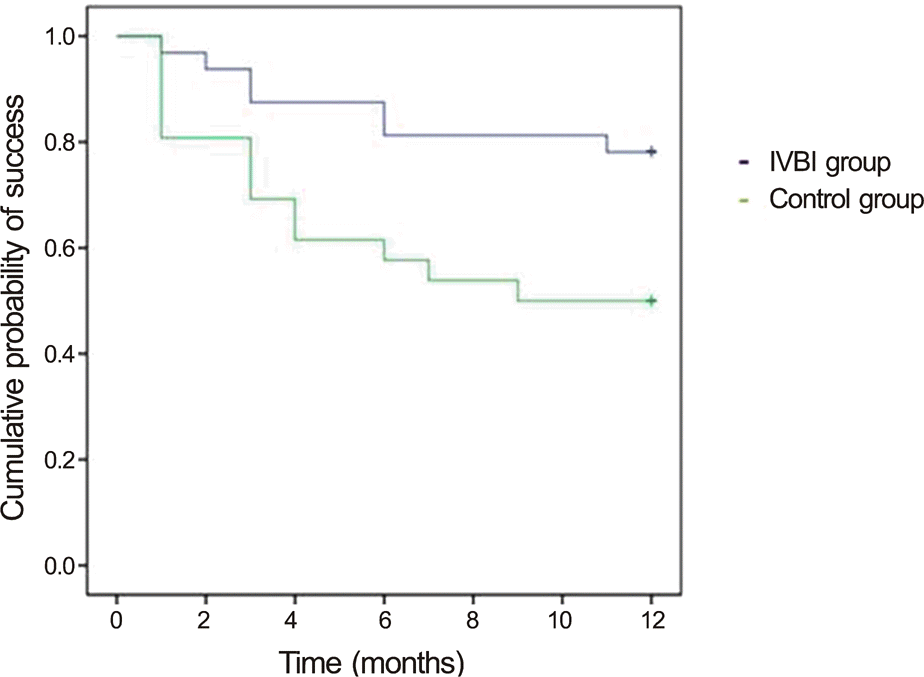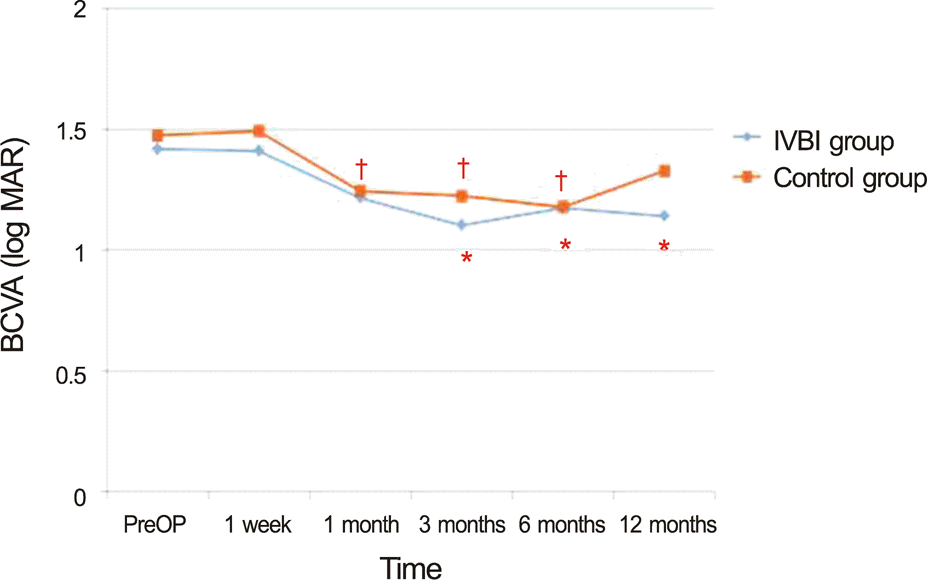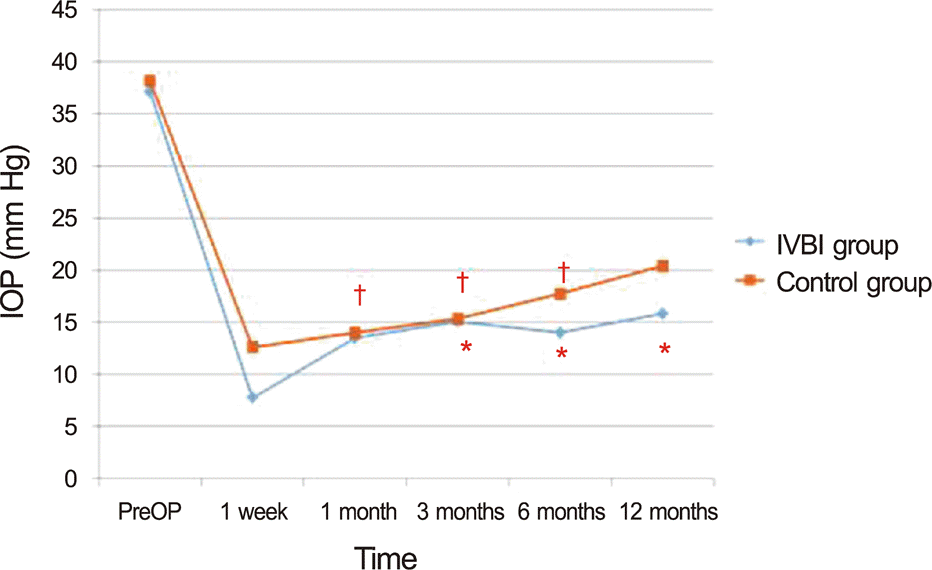Abstract
Purpose
To evaluate the efficacy of preoperative intravitreal bevacizumab injection (IVBI) and prognostic factors of surgical success in neovascular glaucoma patients, who underwent trabeculectomy.
Methods
A total of 58 patients (58 eyes) diagnosed with neovascular glaucoma who underwent trabeculectomy between 2003 and 2013 were enrolled in this retrospective study. Trabeculectomy with mitomycin C was performed between 2003 and 2006 and additional preoperative IVBI with the above mentioned technique was performed between 2007 and 2013. To evaluate the efficacy of preoperative IVBI, the patients were divided into the preoperative IVBI group and control group. Best corrected visual acuity (BCVA) and intraocular pressure (IOP) were measured from preoperative to postoperative 12 months. To evaluate the prognostic factors related to surgical success, the following was investigated: age, lens status, preoperative IVBI, time interval between preoperative IVBI and trabeculectomy, previous vitrectomy and, postoperative complications.
Results
Trabeculectomy with mitomycin C only was performed in 26 eyes and additional preoperative IVBI was performed in 32 eyes. Surgical success was 81.3% in the IVBI group and 57.7% in the control group at postoperative 6 months (p = 0.012), and 78.1% in the IVBI group and 50.0% in the control group at postoperative 12 months (p = 0.021). Statistically significant IOP reduction effect was observed in the IVBI group (p = 0.048), and reduced anti-glaucoma eye drop usage was observed in the IVBI group (0.4) compared with 0.8 in the control group (p = 0.040). Postoperative hyphema (hazard ratio [HR] = 2.872, p = 0.044) and preoperative IVBI (HR = 0.280, p = 0.030) were considered risk factors for surgical failure in univariate analysis, however, only preoperative IVBI was statistically significant in multivariate analysis (p = 0.046).
Go to : 
References
1. Kotecha A, Spratt A, Ogunbowale L, et al. Intravitreal bevacizumab in refractory neovascular glaucoma: a prospective, observational case series. Arch Ophthalmol. 2011; 129:145–50.
2. Olmos LC, Lee RK. Medical and surgical treatment of neovascular glaucoma. Int Ophthalmol Clin. 2011; 51:27–36.

3. Aiello LP, Avery RL, Arrigg PG, et al. Vascular endothelial growth factor in ocular fluid of patients with diabetic retinopathy and other retinal disorders. N Engl J Med. 1994; 331:1480–7.

4. Brown GC, Magargal LE, Schachat A, Shah H. Neovascular glaucoma. Etiologic considerations. Ophthalmology. 1984; 91:315–20.
5. Tripathi RC, Li J, Tripathi BJ, et al. Increased level of vascular endothelial growth factor in aqueous humor of patients with neovascular glaucoma. Ophthalmology. 1998; 105:232–7.

6. Cashwell LF, Marks WP. Panretinal photocoagulation in the management of neovascular glaucoma. South Med J. 1988; 81:1364–8.

7. Mandal AK, Majji AB, Mandal SP, et al. Mitomycin-C-augmented trabeculectomy for neovascular glaucoma. A preliminary report. Indian J Ophthalmol. 2002; 50:287–93.
8. Kiuchi Y, Sugimoto R, Nakae K, et al. Trabeculectomy with mitomycin C for treatment of neovascular glaucoma in diabetic patients. Ophthalmologica. 2006; 220:383–8.

9. Silva Paula J, Jorge R, Alves Costa R, et al. Short-term results of intravitreal bevacizumab (Avastin) on anterior segment neovascularization in neovascular glaucoma. Acta Ophthalmol Scand. 2006; 84:556–7.

10. Iliev ME, Domig D, Wolf-Schnurrbursch U, et al. Intravitreal bevacizumab (Avastin) in the treatment of neovascular glaucoma. Am J Ophthalmol. 2006; 142:1054–6.

11. Yazdani S, Hendi K, Pakravan M, et al. Intravitreal bevacizumab for neovascular glaucoma: a randomized controlled trial. J Glaucoma. 2009; 18:632–7.
12. Wakabayashi T, Oshima Y, Sakaguchi H, et al. Intravitreal bevacizumab to treat iris neovascularization and neovascular glaucoma secondary to ischemic retinal diseases in 41 consecutive cases. Ophthalmology. 2008; 115:1571–80. 1580.e1-3.

13. Nakatake S, Yoshida S, Nakao S, et al. Hyphema is a risk factor for failure of trabeculectomy in neovascular glaucoma: a retrospective analysis. BMC Ophthalmol. 2014; 14:55.

14. Saito Y, Higashide T, Takeda H, et al. Beneficial effects of pre-operative intravitreal bevacizumab on trabeculectomy outcomes in neovascular glaucoma. Acta Ophthalmol. 2010; 88:96–102.

15. Alkawas AA, Shahien EA, Hussein AM. Management of neovascular glaucoma with panretinal photocoagulation, intravitreal bevacizumab, and subsequent trabeculectomy with mitomycin C. J Glaucoma. 2010; 19:622–6.

16. Lee JW, Lai JS, Yick DW, Tse RK. Retrospective case series on the long-term visual and intraocular pressure outcomes of phacomor-phic glaucoma. Eye (Lond). 2010; 24:1675–80.

18. Fernández-Vigo J, Castro J, Cordido M, Fernández-Sabugal J. Treatment of diabetic neovascular glaucoma by panretinal ablation and trabeculectomy. Acta Ophthalmol (Copenh). 1988; 66:612–6.

19. Parrish R, Herschler J. Eyes with end-stage neovascular glaucoma. Natural history following successful modified filtering operation. Arch Ophthalmol. 1983; 101:745–6.
20. Kang JY, Nam KY, Lee SJ, Lee SU. The effect of intravitreal bevacizumab injection before Ahmed valve implantation in patients with neovascular glaucoma. Int Ophthalmol. 2014; 34:793–9.

21. Takihara Y, Inatani M, Kawaji T, et al. Combined intravitreal bevacizumab and trabeculectomy with mitomycin C versus trabeculectomy with mitomycin C alone for neovascular glaucoma. J Glaucoma. 2011; 20:196–201.

Go to : 
 | Figure 1.Cumulative probability of the surgical success of the preoperative intravitreal bevacizumab injection (IVBI) group and the control group after trabeculectomy for neovascular glaucoma by Kaplan-Meier Survival Analysis. |
 | Figure 2.Mean best corrected visual acuity (BCVA, log MAR) changes in the preoperative intravitreal bevacizumab injection (IVBI) group and the control group after trabeculectomy for neovascular glaucoma. PreOP = preoperation. *Statistically significant changes compared to preoperative BCVA in IVBI group; †Statistically significant changes compared to preoperative BCVA in control group. |
 | Figure 3.Mean intraocular pressure (IOP) changes in the pre-operative intravitreal bevacizumab injection (IVBI) group and the control group after trabeculectomy for neovascular glaucoma. PreOP = preoperation. *Statistically significant changes compared to preoperative IOP in IVBI group. †Statistically significant changes compared to preoperative IOP in control group. |
Table 1.
Baseline characteristics of trabeculectomy patients in neovascular glaucoma
Table 2.
Baseline characteristics of IVBI and control group
Table 3.
Complications of the IVBI group and the control group
| IVBI group (n, %) | Control group (n, %) | p-value | |
|---|---|---|---|
| Hyphema | 5 (15.6) | 9 (34.6) | 0.085 |
| Choroidal detachment | 13 (40.6) | 8 (30.8) | 0.250 |
Table 4.
Multivariate Cox proportional hazard regression model for hyphema in neovascular glaucoma
| Hazard ratio (95% CI) | p-value | |
|---|---|---|
| Eye (OD/OS) | 0.513 (0.135-1.940) | 0.325 |
| Sex (M/F) | 1.017 (0.241-4.298) | 0.982 |
| Preoperative IVBI | 0.374 (0.097-1.439) | 0.153 |
| Preoperative IOP | 1.049 (0.989-1.112) | 0.111 |
Table 5.
Regression of neovascularization of iris period and postoperative anti-glaucoma eye drop usage in the IVBI group and the control group
| IVBI group | Control group | p-value | |
|---|---|---|---|
| Regression of NVI period (days) | 15.53 ± 12.66 | 46.42 ± 49.75 | 0.000 |
| Numbers of anti-glaucoma eye drop usage | 0.4 ± 0.8 | 0.8 ± 1.1 | 0.040 |
Table 6.
Univariate Cox proportional hazard regression model for surgical failure of trabeculecomy in neovascular glaucoma
Table 7.
Multivariate Cox proportional hazard regression model for surgical failure of trabeculecomy in neovascular glaucoma




 PDF
PDF ePub
ePub Citation
Citation Print
Print


 XML Download
XML Download